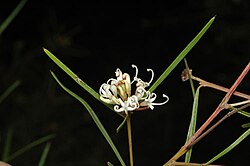Biology:Grevillea wiradjuri
| Grevillea wiradjuri | |
|---|---|

| |
| In the Australian National Botanic Gardens | |
| Scientific classification | |
| Kingdom: | Plantae |
| Clade: | Tracheophytes |
| Clade: | Angiosperms |
| Clade: | Eudicots |
| Order: | Proteales |
| Family: | Proteaceae |
| Genus: | Grevillea |
| Species: | G. wiradjuri
|
| Binomial name | |
| Grevillea wiradjuri Makinson[1]
| |
| Synonyms[1] | |
| |
Grevillea wiradjuri is species of flowering plant in the family Proteaceae and is endemic to inland New South Wales. It is an open, erect or dwarf shrub with linear leaves, and clusters of 8 to 20 white flowers.
Description
Grevillea wiradjuri is an open, erect or dwarf shrub that typically grows to a height of 0.2–1.8 m (7.9 in–5 ft 10.9 in), and sometimes forms a rhizome. Its leaves are linear, 30–75 mm (1.2–3.0 in) long and 0.7–1.3 mm (0.028–0.051 in) wide. The edges of the leaves are rolled under enclosing the lower surface apart from the mid-vein. The flowers are arranged in sessile clusters of 8 to 20 on the ends of branches and surrounded by the foliage, the pistil 7–9 mm (0.28–0.35 in) long. The flowers are white, sometimes becoming slightly pink or red as they age, and the style is strongly curved near its tip. Flowering occurs from August to December and the fruit is a glabrous, oval follicle 9–10 mm (0.35–0.39 in) long.[2][3]
Taxonomy
Grevillea wiradjuri was first formally described in 2000 by Robert Makinson in the Flora of Australia from specimens collected by Michael Crisp near Temora in 1988.[4] The specific epithet (wiradjuri) refers to the Wiradjuri people, who occupied country where this species is found.[5]
Distribution and habitat
This grevillea grows in forest or woodland, usually in stony places on low ridges between Temora, Barmedman and Ariah Park with disjunct populations near Parkes and in Goobang National Park, in inland New South Wales.[2][3]
References
- ↑ 1.0 1.1 "Grevillea wiradjuri". Australian Plant Census. https://biodiversity.org.au/nsl/services/apc-format/display/164743.
- ↑ 2.0 2.1 Makinson, Robert O.. "Grevillea wiradjuri". Royal Botanic Garden Sydney. https://plantnet.rbgsyd.nsw.gov.au/cgi-bin/NSWfl.pl?page=nswfl&lvl=sp&name=Grevillea~wiradjuri.
- ↑ 3.0 3.1 "Grevillea wiradjuri". Australian Biological Resources Study, Department of Agriculture, Water and the Environment: Canberra. https://profiles.ala.org.au/opus/foa/profile/Grevillea%20wiradjuri.
- ↑ "Grevillea wiradjuri". APNI. https://id.biodiversity.org.au/instance/apni/8096847.
- ↑ Makinson, Robert O. (2000). Flora of Australia. 17A. Canberra: Australian Biological Resources Study. p. 501. https://www.dcceew.gov.au/sites/default/files/env/pages/9956603b-17a1-4fe2-b47a-3addcd924fc0/files/flora-australia-17a-proteaceae-2-grevillea.pdf. Retrieved 23 April 2023.
Wikidata ☰ Q15583363 entry
 |

